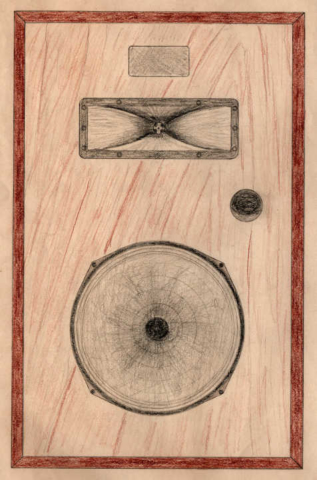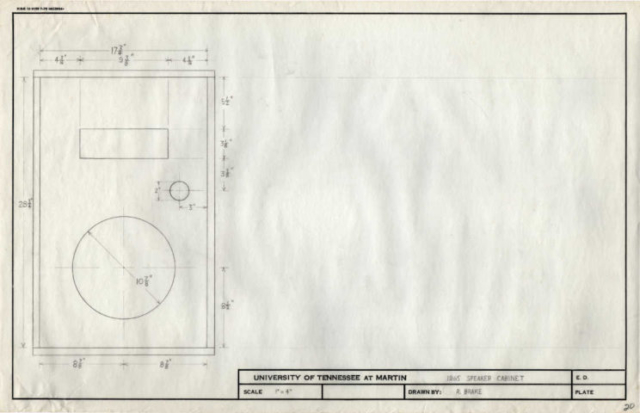For a very long time I’ve had an interest in audio equipment and over time this interest has come to include building my own. Many years ago my parents got rid of an old console stereo that no longer worked. I was fascinated with the 11 inch woofers and the heavy horn tweeters that created the sound for this antique, so I removed them before the console was disposed of. The woofers were lightweight compared to the current woofers I saw in speakers at the time. I bought a book at Radio Shack on building and designing speakers and built a set of speaker cabinets to house these drivers. Since I didn’t have any technical specs for these old speakers to design a cabinet with, I designed the cabinets around the size of the speakers themselves, the same basic design as most other speakers from the ’80s. I think they were probably each around 2 1/2 cubic feet in volume, big enough to house the 11 inch wide woofer and the 11-or-so inch deep horn tweeter.
One of the tweeters didn’t work, but upon taking it apart I discovered that one of the hair-thin wires connecting the tweeter to the terminals was broken. Being so small, it was difficult to solder for a novice like me, but I managed to get it working. One of the woofers had a small tear in it, but I was able to fix that with clear fingernail polish. I also bought a pair of piezo horn tweeters and a pair of basic 3-way crossovers from Radio Shack. I didn’t have the equipment to take any sound measurements, but the old horn tweeters were not performing well at the higher listening frequencies, so I used them as midrange drivers and added the new tweeters. These definitely were not “matched” speaker drivers. I also cut a small 2 inch diameter hole to act as a “bass reflex” port. For this old, cheap woofer I’m sure it didn’t add much to the sound, if anything at all, but I figured it shouldn’t hurt because these woofers were not originally in a sealed enclosure to begin with.
This was a few years after high school and I was taking some mechanical engineering classes at the time, and I met a friend at school who shared my audio interests. He was having a set of speakers custom built by a local man who built and installed professional audio systems. One day we watched this man make the crossovers for these speakers. It was a cycle of feeding white noise through the speaker and measuring the frequency response with a microphone on a spectrum analyzer, then adding more wire to the coil of the inductor if the frequency response still had a gap in it. This was before I had any basic understanding of filter design. Watching this man make speakers helped me along with my own ideas.
I had built the cabinets out of 3/4 inch plywood. Fiberboard would have been better, but for some reason I decided to go with plywood. Probably because I knew these speakers weren’t going to have high quality sound anyway. However, I still made a high-quality build using the plywood. I sanded everything down, caulked the inside, and added a little insulation. Apparently I never took a picture of these cabinets (this was a time before people took a picture of everything), but I did make some drawings at the time I was planning my design.
The sound of these speakers was, to be realistic, unremarkable. An audiophile would have rated them less than “radio quality” (garbage), but to me they sounded awesome, simply because I built them. Yes, I knew there was a lot that was missing from their sound, but these speakers were my Frankenstein’s monster, something out of the trash heap that I brought back to life. This gave me a feeling that filtered out the blandness of their sound.
At one point, these homemade speakers were used as speaker stands for my regular speakers until I found a set of speaker stands that I liked. Eventually, I no longer felt the desire to hook them up and listen to them as it was mostly a novelty after listening to “real” speakers, so they eventually got disassembled and the wood used for scrap. However, the whole process was a grand learning experience.
About a year later, I built a custom-fit subwoofer box for the trunk of my ’84 Olds Cutlass that was tuned for a pair of Pioneer 12 inch subs that I had bought. I used a dense, heavy particle board, and it was shaped to fit perfectly on the ledge in the trunk, pushing the subs up against the back seat. It was also designed with the optimal volume, a little less than 3 cubic feet per partition. I cut 12″ holes in the insulation of the back seat and these subs sounded great. The sealed enclosure gave them a very tight, “punchy” bass, not the looser, lower bass that seems to be designed more for people outside the car than people inside. The finished build was very solid and professional, as was the sound (even if I do say so myself). It was a shame, though, that it was custom-made to fit only in that model car. It was custom-made for those particular subs, too, but a port could have been added to make it useable with other subs. I eventually got rid of the car and the subs. Many years would go by before I would build anything like this again.
It is a great feeling to build something with your own hands as opposed to something that you could have bought pre-assembled, something that you just plug in and it works (hopefully). It could be a bookshelf that you have to assemble yourself, a paint-by-number kit (I loved those as a kid), a drawing or painting, or something as complicated as a kit car. Anything created by a child that a parent keeps takes on new meaning as the years go by.
It can be easy to look around at the world and develop a feeling of helplessness. One way to push back against that feeling is to create and build things with your own hands. If you have a hankering to build something, build it, whether it be art, writing, music, shelves, electronics, woodworking, a windmill, a car, a shed or whatever. Take classes for any skills you might need, and read all the books and websites you need to acquire the skill or knowledge. Join groups that focus on the skill or craft. Online groups are nice, but local groups where you can meet like-minded people face-to-face are even better. Share what you create with those around you.
Maybe you once created things but over time life started getting in the way. Making time to build and create physical things that you can see, feel and maybe hear is well worth the effort. The most important thing is to take action. In the end, you will be glad you did.


